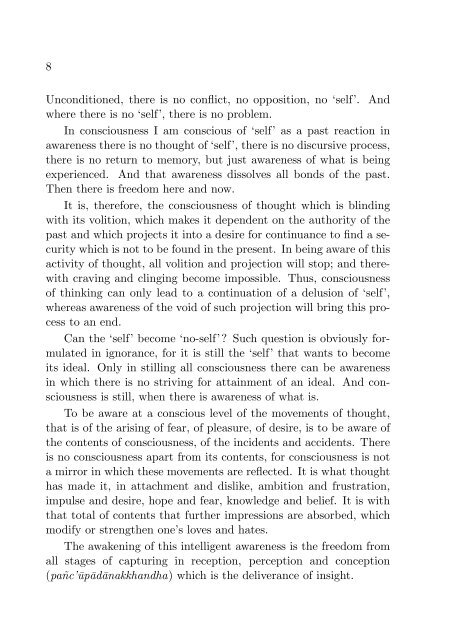Awareness in Buddhist Meditation
A detailed description of awareness in Buddhist Meditation.
A detailed description of awareness in Buddhist Meditation.
Create successful ePaper yourself
Turn your PDF publications into a flip-book with our unique Google optimized e-Paper software.
8<br />
Unconditioned, there is no conflict, no opposition, no ‘self’. And<br />
where there is no ‘self’, there is no problem.<br />
In consciousness I am conscious of ‘self’ as a past reaction <strong>in</strong><br />
awareness there is no thought of ‘self’, there is no discursive process,<br />
there is no return to memory, but just awareness of what is be<strong>in</strong>g<br />
experienced. And that awareness dissolves all bonds of the past.<br />
Then there is freedom here and now.<br />
It is, therefore, the consciousness of thought which is bl<strong>in</strong>d<strong>in</strong>g<br />
with its volition, which makes it dependent on the authority of the<br />
past and which projects it <strong>in</strong>to a desire for cont<strong>in</strong>uance to f<strong>in</strong>d a security<br />
which is not to be found <strong>in</strong> the present. In be<strong>in</strong>g aware of this<br />
activity of thought, all volition and projection will stop; and therewith<br />
crav<strong>in</strong>g and cl<strong>in</strong>g<strong>in</strong>g become impossible. Thus, consciousness<br />
of th<strong>in</strong>k<strong>in</strong>g can only lead to a cont<strong>in</strong>uation of a delusion of ‘self’,<br />
whereas awareness of the void of such projection will br<strong>in</strong>g this process<br />
to an end.<br />
Can the ‘self’ become ‘no-self’? Such question is obviously formulated<br />
<strong>in</strong> ignorance, for it is still the ‘self’ that wants to become<br />
its ideal. Only <strong>in</strong> still<strong>in</strong>g all consciousness there can be awareness<br />
<strong>in</strong> which there is no striv<strong>in</strong>g for atta<strong>in</strong>ment of an ideal. And consciousness<br />
is still, when there is awareness of what is.<br />
To be aware at a conscious level of the movements of thought,<br />
that is of the aris<strong>in</strong>g of fear, of pleasure, of desire, is to be aware of<br />
the contents of consciousness, of the <strong>in</strong>cidents and accidents. There<br />
is no consciousness apart from its contents, for consciousness is not<br />
a mirror <strong>in</strong> which these movements are reflected. It is what thought<br />
has made it, <strong>in</strong> attachment and dislike, ambition and frustration,<br />
impulse and desire, hope and fear, knowledge and belief. It is with<br />
that total of contents that further impressions are absorbed, which<br />
modify or strengthen one’s loves and hates.<br />
The awaken<strong>in</strong>g of this <strong>in</strong>telligent awareness is the freedom from<br />
all stages of captur<strong>in</strong>g <strong>in</strong> reception, perception and conception<br />
(pañc’ūpādānakkhandha) which is the deliverance of <strong>in</strong>sight.

















